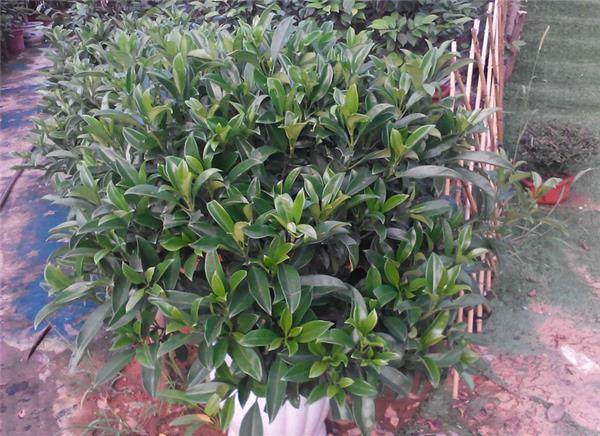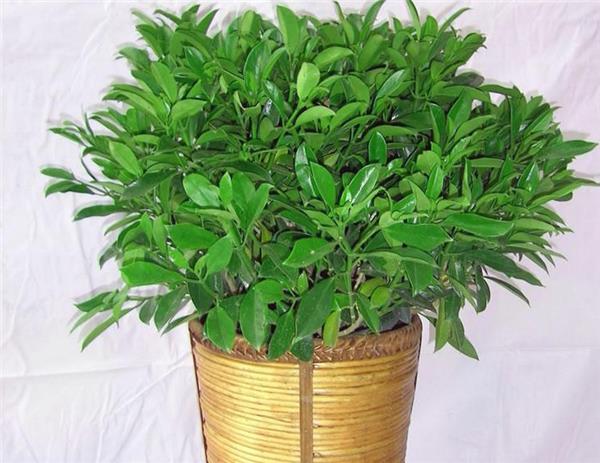How does African jasmine reproduce African jasmine
How does African jasmine reproduce? Friends who want to know might as well take a look at the following introduction to the breeding methods of African jasmine.

How African jasmine propagates
1. Sowing and reproduction
The sowing and propagation of African jasmine is suitable to collect ripe fruit from October to December, remove the seeds, sow or row them on the loose and fertile sandy soil seedling bed, cover the soil with a thickness of 2 to 3 meters, and cover with rice straw or plastic film to keep warm against cold, or store the seeds in the seeds to show white before sowing. The seeds sown in late autumn and early winter can not emerge until the next spring, remove the covered grass in time after emergence, strengthen the management of water and fertilizer, and set up a shed to shade after summer, which is expected to cultivate tall African jasmine with better dry shape.
2. Cuttage propagation
African jasmine can be planted from the end of April to October, but it is best to be planted in the Meiyu period from June to July, and the rooting effect is ideal. Cut 1-2-year-old strong branches as cuttings, ear length 12 to 15 meters, with 2 to 3 half leaves, the lower incision is best located at 0.2 to 0.3 meters below the node, and insert it in peat soil, sandy soil, vermiculite or yellow soil, but the rooting effect of peat soil is the best, covered with plastic film to protect moisture, pay attention to shed shade in sunny weather, it can take root after 1 to 2 months, and the survival rate can reach more than 80%.

3. Ramet propagation
Between March and April, when African jasmine is just beginning to sprout, remove the tufted African jasmine from the flowerpot, or dig up the planted African jasmine from the soil, shake off part of the persistent soil, and cut it with a sharp knife where the root system is weak. so that each clump with at least 2 to 3 stems, and with part of the intact root system, African jasmine will be planted separately or potted. There are many sprouting tillers on the roots near the ground of African jasmine, which can be truncated from the roots and planted separately, which is also very simple and convenient.
4. Striping propagation
① low pressure, in the south, in April, the middle and lower parts of the 2-to 3-year-old strong branches sprouting at their bases were annularly peeled or scratched, and then forcibly buried in the excavated grooves on the ground and covered with thick soil, which could take root after about 40 to 50 days. From July to August, African jasmine is cut and separated from the mother plant, and African jasmine is planted separately or potted. This method is widely used in production.
② high pressure, the northern region of potted African jasmine out of the house at the end of April, in the 2-year-old strong branches of the node 0.5cm, for circular peeling, peeling width of about 3 times the branch thickness, and then use plastic film to wrap wet peat or peat in the ring peeling place, the top of the soil mass left a water outlet, to maintain soil mass moist, 2 to 3 months later can take root, enthusiasts can use this method to breed African jasmine gift flower friends.

Finally, I would like to introduce the role of African jasmine.
1. The ornamental value of the role of African jasmine
The leaves of African jasmine are thick and green, which can give people a sense of pleasure visually. African jasmine branches as emerald, leaves shiny, flowers slightly fragrant, elegant flowers, each five-petal, umbrella-shaped, clustered at the top of the flower branch. The flowering period is very long, blooming in winter and summer, and blooming most brightly in spring and summer. It is very suitable for home display. It has a strong ornamental value.
2. The role of African jasmine in beautifying the home
For African jasmine, a plant with exuberant branches and leaves, it is very compatible with the pastoral and Chinese-style home environment such as American style and pastoral style. African jasmine is so luxuriant that even the American pastoral style can't criticize it. And the Chinese style pays attention to the appearance of plant leaves, not sharp and round African jasmine can be regarded as a good partner of home style. If placed properly, it will make the home exude a different charm.

3. The role of African jasmine in improving the home environment
The leaves of African jasmine are thick and green, which can give people a sense of pleasure visually. The volatile oil produced by African jasmine has significant germicidal effect, which can relax people, facilitate sleep, and improve work efficiency. African jasmine has the effect of sterilization and detoxification in medicine. On the other hand, these volatile oils can regulate the hormonal balance in the body, the aroma of African jasmine is also light, feel very fresh, and play a good role in improving the home environment.
However, African jasmine is not suitable to be kept indoors for a long time. The aroma of African jasmine is overflowing after flowering, and the aroma is actually some volatile chemicals, the composition is more complex. Different people have different reactions to the same odor. If the environmental space is very large and the amount of plants is very small, it may not be a big problem. However, for a long time in the strong floral environment, it is easy to cause adverse reactions such as shortness of breath, dizziness, nausea, chest tightness and so on.
4. The role of African jasmine in fengshui
African jasmine also has a certain fengshui effect. Put African jasmine on the windowsill to attract wind into the house. The volume of African jasmine is usually relatively large, if placed in the window, when the wind blows, he will block the wind, change the direction of the wind, let the wind turn and blow to the home, there is wind blowing into the home, I believe that fengshui will be good. African jasmine leaves are relatively dark in color and can ward off evil spirits.
Feel very fresh, to improve the home environment has a good role.
However, African jasmine is not suitable to be kept indoors for a long time. The aroma of African jasmine is overflowing after flowering, and the aroma is actually some volatile chemicals, the composition is more complex. Different people have different reactions to the same odor. If the environmental space is very large and the amount of plants is very small, it may not be a big problem. However, for a long time in the strong floral environment, it is easy to cause adverse reactions such as shortness of breath, dizziness, nausea, chest tightness and so on.
4. The role of African jasmine in fengshui
African jasmine also has a certain fengshui effect. Put African jasmine on the windowsill to attract wind into the house. The volume of African jasmine is usually relatively large, if placed in the window, when the wind blows, he will block the wind, change the direction of the wind, let the wind turn and blow to the home, there is wind blowing into the home, I believe that fengshui will be good. African jasmine leaves are relatively dark in color and can ward off evil spirits.
Related
- Wuhan Hospital Iron Tree Blooming Result Was Instantly Frightened by the Gardener Master
- Which variety of camellia is the most fragrant and best? Which one do you like best?
- What is the small blue coat, the breeding methods and matters needing attention of the succulent plant
- Dormancy time and maintenance management of succulent plants during dormancy
- Minas succulent how to raise, Minas succulent plant pictures
- What are the varieties of winter succulent plants
- How to raise succulent plants in twelve rolls? let's take a look at some experience of breeding twelve rolls.
- Attention should be paid to water control for succulent plants during dormant period (winter and summer)
- Watering experience of twelve rolls of succulent plants
- Techniques for fertilizing succulent plants. An article will let you know how to fertilize succulent plants.



